Economic and Social Changes: Facts, Trends, Forecast @volnc-esc-en
Статьи журнала - Economic and Social Changes: Facts, Trends, Forecast
Все статьи: 1728
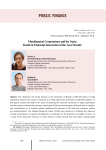
Metallurgical corporations and the state: trends in financial interaction of the last decade
Статья научная
The dominant role of big business in the formation of Russia's GDP determines its high importance both for the country's economy as a whole and for the economies of individual regions. In this regard, studies that address the issues of assessing the financial interaction of large corporations with the state are relevant and necessary. Interaction of these economic agents with each other is complex and contradictory, as in modern market conditions the interests of the state and economic entities are multidirectional. The Vologda Research Center of RAS pays attention to studying the influence of large corporations on regional development, in particular on the formation of budget revenues. As a result of the long-term research, we have formed a serious factual base that allows understanding the main interaction features of large businesses with the regional and federal budgets, to determine systemic shortcomings of the state's tax policy including those related to the taxation of profits and income of corporate owners. However, currently, there is no single mechanism in the scientific literature that can be used to most comprehensively assess the financial interaction of large businesses with the region. At the same time, the results of such an assessment can become a serious foundation for justifying many management decisions. The purpose of the study is to assess the trends of financial interaction between the state and corporations on the basis of the developed methodological tools. The authors have tested the methodology in the case of ferrous metallurgy industry. The object of the study is the financial interaction of large ferrous metallurgy corporations (PJSC “Severstal”, PJSC “MMK” and PJSC “NLMK”) with the state. The paper uses the methods of structural (weight) analysis, coefficient analysis linking the microeconomic indicators of enterprises with the macroeconomic indicators of the home regions, the index method, and the method of level estimation when creating the methodological assessment tools.
Бесплатно
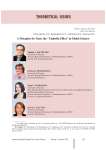
Metaphor for trust: the “umbrella effect” in global science
Статья научная
The purpose of the article is to consider the foreign experience in conceptualization and study of trust, to provide a critical review of the multidisciplinary issues of trust in modern world science, the relevance of which is explained by the increasing shortage of public trust. The research novelty of the study lies in the identification of forms, types, and trends in the subject area of trust in terms of determining the internal and interdisciplinary boundaries of various humanitarian fields. The interdisciplinary subject of trust in terms of the “umbrella effect” of competing paradigms and approaches is presented; the definition of trust as a multidimensional construct is conceptualized; the category-concept set of classification of trust include variables: resource pools (availability and configuration); rules of the game (resource share and coordination); target functions (efficiency, productivity); functions focused on people (social roles and practices, interpersonal relations); sense-making (realistic and perceived effect); focus on action (practical effects); focus on perception (interpretive effects)...
Бесплатно
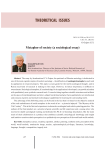
Metaphor of society (a sociological essay)
Статья научная
The essay by Academician G.V. Osipov, the patriarch of Russian sociology, is dedicated to one of the most cognitive topics of modern sociology - identification of sociological metaphor as such and its application in research projects. This topic is avant-garde for the world sociological thought, and in Russia such kind of research is making its first steps. However, its future importance is difficult to overestimate. Sociological metaphor, if a methodology for its application is developed, can provide scientists with qualitatively new synthetic research tools. It can also bring together scientific structures and artifacts on the space of interdisciplinary and inter-subject borderland and give them qualitatively new intellectual and sensuous (system and mental) technological capabilities for learning the surrounding world. The advantage of the following essay can be found in the fact that it is based on the objective analysis of the real embodiment of social metaphor in the work of art - a pictorial triptych “The Mystery of the21st Century”...
Бесплатно
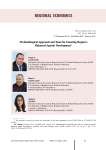
Methodological approach and tools for ensuring region's balanced spatial development
Статья научная
Due to the concentration of labor, financial, and other resources in agglomerations and “denudation” of regions' periphery, a number of significant problems are becoming more acute in the transformation process of spatial economic structure. Such problems threaten the balance of intra- and interregional development. One of them is an important differentiation of Russian regions' municipalities in terms of socio-economic development level. There is a dilemma of choosing the regional spatial policy vector: either to support the growth points' development (agglomerations, special economic zones, territories of advanced socio-economic development), or to reduce socio-economic inequality through additional support for the periphery development. Using the integration of the concepts of the reference frame and sub-regional approach, the research proposes a methodological approach to the balanced spatial development of the region. On the region's territory, the research distinguishes natural sub-regions, which are the elements of the territory's reference economic frame, and artificial sub-regions, which are based on inter-municipal cooperation. The essence of the approach is to establish balance between regulation of natural economic processes in the region (for example, institutionalization and reduction of agglomerations' negative effects) and state support for depressed territories' development (for example, program sub-regions' formation). Its usage in the regional management practice allows forming methodological basis for working out strategic documents for the region's spatial development, economic, organizational, institutional, and social instruments of regional policy. The work presents a set of tools for improving the spatial development balance of the Republic of Bashkortostan, related to the development of natural sub-regions which are already objective growth points in the region, as well as aimed at stimulating the economic self-development of depressed and peripheral territories of the Republic of Bashkortostan.
Бесплатно
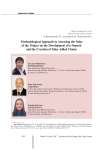
Статья научная
Development of companies should aim to increase their value; it is provided by applying the concept of value-based management. This approach can also be the basis for the growth of the value of integrated companies or groups, strategic projects and economic sectors. The mineral resources sector is characterized by a high level of vertical integration, and its own effect of technological, economic and institutional factors that determine the value of mineral assets and products. Assessment of value of the projects of the sectoral level can be carried out with the application of the concept of added value and value chains designed on this basis. The aim of the present research is to substantiate scientifically an approach to assessing the project for establishing the tin industry in the Republic of Kazakhstan taking into account the concept of value added. We use the following research methods: comparative analysis, system approach, strategic analysis, and managerial decision-making methods...
Бесплатно
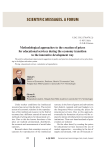
Статья научная
The article substantiates improvement suggestions in policy and practice of educational service price forming in the higher education system.
Бесплатно

Methodological approaches to the estimation of the regional public health services efficiency
Статья научная
The publication is devoted to the problem of estimation of the regional public health services’ efficiency. In the article the nowadays existing approaches to estimation of the expenses’ efficiency for public health services are discussed, their brief comparative analysis is given. The conclusion about inexpediency of use of the techniques based on the analysis of the resource component of the public health services, without taking into account social effect, is drawn. As an alternative the technique based on the parallel estimation of the financial (the expense for rendering medical aid) and the demographic (losses of the population in the region from premature death rate) parameters is offered.
Бесплатно
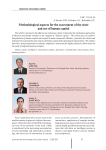
Methodological aspects for the assessment of the state and use of human capital
Статья научная
The article is devoted to the efficient use of human capital. It describes the methodical approaches of Russian and foreign scholars to the category of “human capital”. The article gives an author's interpretation of human capital and reveals its main components. Besides, t provides the criteria and indicators for assessing the state and use of human capital of the agricultural organizations. The authors describe a tested mechanism to enhance employees' motivation for highly productive labor based on the study of staff motivational complex.
Бесплатно
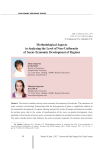
Статья научная
This article considers uneven socio-economic development of territories. The experience of many countries convincingly demonstrates that the heterogeneity of space is a significant obstacle to the sustainable development of regions. Having analyzed the works of foreign and domestic scientists, the authors prove that in the course of transformation of the views on spatial development, there gradually evolved an idea of uneven socio-economic development as an objective feature of any territory. The study classifies factors that influence the socio-economic inequality of territories and determine its complexity. The authors pay attention to the fact that when studying development unevenness the researchers use different terms (“differentiation”, “asymmetry”, “polarization”, “disproportion”) that are often treated as similar. Therefore, the paper puts forward a hypothesis that there exists a relationship between these concepts that have similar meaning, and the special nature of this relationship is manifested in the fact that these concepts represent different stages of unevenness...
Бесплатно
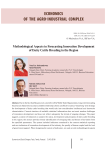
Methodological aspects in forecasting innovation development of dairy cattle breeding in the region
Статья научная
Due to the fact that Russia is now a member of the World Trade Organization, long-term forecasting becomes an objectively necessary condition that helps choose an effective science-based long-term strategy for development of dairy cattle breeding that would take into consideration intellectual and innovative characteristics. Current structure of available statistical information does not meet modern challenges of innovation development and does not reflect adequately the trends of ongoing changes. The paper suggests a system of indicators to analyze the status, development and prospects of dairy cattle breeding in the region; this system provides timely identification of emerging risks and threats of deviation from the specified parameters. The system included indicators contained in the current statistical reporting and new indicators of innovation development of the industry, the quality of human capital and the level of government support. When designing the system of indicators, we used several methodological aspects of the Oslo Manual, which the Federal State Statistics Service considers to be an official methodological document concerning the collection of information about innovation activities...
Бесплатно
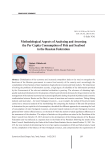
Статья научная
Globalization of the economy and increased competition leads to the need to strengthen the functions of the Russian government to ensure food security of the country and, accordingly, the consolidation of mechanisms of state regulation of agricultural economy and food markets. The importance of solving the problems of information security, a high degree of reliability of the information provided by the Government of the relevant statistical authorities is growing. The relevance of obtaining high-quality statistical information for the adoption of timely and informed decisions by the government on the management of the national economy has increased significantly during the period of political and economic confrontation between Russia and the West in terms of sanctions and counter-sanctions. Taking fishing industry and its product - the water biological resources - as an example, the author of the present study carried out a structural analysis of the methodology for composing the balance of fish and fish products to determine the per capita level of consumption, described the different approaches to assessing the level of consumption of water biological resources, structured export indicators of water biological resources gathered from various official sources, on the basis of which the author revealed significant differences in the assessment of the situation...
Бесплатно
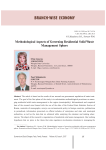
Methodological aspects of governing residential solid waste management sphere
Статья научная
The article is based on the results of our research on government regulation of waste treatment. The goal of the first phase of the study is to substantiate methodological provisions on arranging residential solid waste management in the region (municipality). Informational and empirical base of the research was formed with the use of the data of the Federal State Statistics Service of Russia, materials of monographs, surveys on environmental policy in foreign countries, publications in periodicals, information presented on official websites of enterprises and state and municipal authorities, as well as the data that we obtained while analyzing the situation and making observations. The object of the research is organization of residential solid waste management. Our working hypothesis that we prove is the thesis that state regulation mechanisms dominate in managing the development of waste treatment sphere and that there is a possibility of limited admission of market self-regulation tools managing residential solid waste treatment in the region (municipality)...
Бесплатно
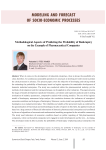
Статья научная
When it comes to the development of industrial enterprises, there is always the possibility of a crisis; therefore, for continuous sustainable operation it is necessary to develop preventive tools to predict the crisis processes in advance. The present paper covers the objective of developing and testing models for estimating the probability of bankruptcy based on logistic regression for sustainable development of domestic industrial enterprises. The study was conducted within the pharmaceutical industry, yet the methods of development and the testing technique can be applied in other industries. The paper presents the stages of model development (predictor formation, correlation and regression analysis) and its testing (evaluation of statistics parameters, comparative analysis with existing models). The use of the logistics model of bankruptcy assessment helps analyze the correlation between the indicators of enterprise’s economic condition and its degree of bankruptcy. Moreover, such a model can quantify the probability of bankruptcy at an industrial enterprise. The reliability and validity of the presented results is confirmed by the generalization of theoretical and methodological studies of experts in this field, the applied results are based on a large amount of financial information of domestic pharmaceutical enterprises and confirmed by the use of algorithms of economic and mathematical modeling recognized in the scientific community. The study used indicators of economic condition based on public reporting of 266 pharmaceutical companies, where one hundred companies were engaged in model development and the rest - its testing. The developed model is able to predict the probability of bankruptcy of pharmaceutical enterprises two years ahead. The small amount of calculations and lack of highly technical calculations helps quickly obtain information about the economic condition and versatile calculation makes it possible to conduct a comparative analysis of enterprises in the context of one industry.
Бесплатно
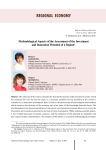
Methodological aspects of the assessment of the investment and innovation potential of a region
Статья научная
The relevance of the study is caused by the fact that the increase of the investment activity, which has remained low over the last few years, is a necessary condition for the transition of the country's economy to an innovative development path. It leads to the preservation of technological backwardness which conserves the structure of the economy with a low share of the knowledge-intensive sector. The interdependence and interconnectedness of investment and innovation processes allows us to review the investment and innovation potential as the basis of their development. While studying scientific papers, it was revealed that issues of content, structure, and the evaluation of this potential are debatable, and they require further comprehension. The purpose of this article is to develop methodological provisions for assessing the investment and innovation potential of the region. In the course of studying the works of domestic and foreign scientists, the authors of the article investigated approaches to determining innovation and investment potentials and methods of their assessment, clarified the content of investment and innovation potential, identified its structural elements, and proposed a methodological approach to its assessment, which allows establishing the relationship between used investment resources and the results of the innovation activity. During the study, we assessed the investment and innovation potential of Russian regions, identified problems of its formation and the usage, as well as trends that make it possible to determine the guidelines for the development of investment and innovation processes. The methodological basis of the research are the methods of system analysis and synthesis, comparison, generalization, grouping and statistical methods. The results of the study may be of practical interest for regional authorities' activities and the management in order to improve the effectiveness of investment and innovation processes. Theoretical generalizations, contained in the article, might be used as materials for the discussion in a scientific discourse.
Бесплатно
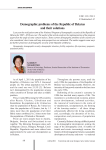
Methodological foundations of sustainable development of the agricultural sector
Статья научная
The paper analyzes the different perspectives on the concept of “sustainability”, “sustainable development”, the content of sustainable development of the agricultural sector as a complex socio-ecological-economic system is clarified and supplemented. The factors and indicators of sustainable development of agriculture are identified.
Бесплатно
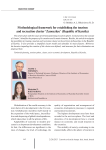
Статья научная
The article deals with the issues of territorial planning in tourism sphere. It characterizes the concept of ‘cluster’, identifies the purposes of its creation and its main elements. Besides, the article investigates the possibility of creating a tourism and recreation cluster on the territory of Zaonezhye in the Republic of Karelia. It also provides a simplified cluster model and identifies its main features. Moreover, the barriers impeding the creation of the cluster are defined, and measures for their elimination are proposed here.
Бесплатно
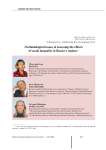
Methodological issues of assessing the effects of social inequality in Russia's regions
Статья научная
The article deals with the issue concerning the assessment of the impact of social inequality on the socio-demographic characteristics of society. The authors evaluate the impact of the social inequality growth in the Russian Federation subjects on the basis of the analysis of the decile ratio dynamics. They propose a methodological approach to determine the degree of dependence of crime rate on the growth of social inequality. The authors compare the influence of the decile ratio and purchasing power on mortality rate in the regions of Russia.
Бесплатно
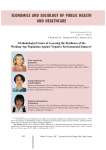
Статья научная
The purpose for the research is to study the resilience of regional human population against environmental impacts based on evaluation of quality indicators of environmental living conditions and promotion of population's health on the one hand, and on population's mortality for a number of causes related to environmental degradation on the other hand. Indicators of environmental degradation may include expanding industrial production, energy consumption, population density, growing number of motor vehicles etc. The study is initiated by the trends of the second epidemiologic transition according to which diseases and causes of mortality are mostly attributable to endogenous factors related to natural ageing of a human body, its declining age-related vitality and resistance to adverse external impacts including environment. The novelty of the research lies in assessment of both population's resilience against this kind of impacts in regions with varied concentration of population and facilities used for economic purposes, and causes of morbidity and mortality from this type of impacts...
Бесплатно
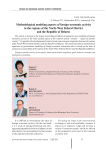
Статья научная
The article is devoted to the urgent researching problems of integration and modeling of foreign economic activity in the little-studied aspect of the relation system “country - region of another country”. It considers the developmental trends of trade and economic integration between the regions of the North-West Federal District and the Republic of Belarus. The article describes a mathematical apparatus of gravitational modeling of foreign-economic interaction that is tested on the base of statistical accountability of the regions of the North-West Federal District and the Republic of Belarus.
Бесплатно
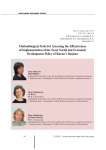
Статья научная
The article considers the issues of improvement of methodological support in assessing the effectiveness of the state social and economic policy in relation to Russia’s northern regions. It provides a brief analysis of methodological approaches and mechanisms to assess the policies based on the function of the area of assessment, the object, subject and target of assessment, and depending on the methods of estimation. The authors point out the absence of a common approach to interpretation of the notions of “effectiveness” and “performance efficiency” of a policy, this fact leads to ambiguity and complexity of assessment. The methodological tools proposed by the authors for assessing the implementation of the policy include key principles and an algorithm. Assessment of policy effectiveness using the proposed tools includes socio-economic, environmental and institutional components. The socio-economic component involves evaluation of the goals and objectives of the policy with regard to Russia’s northern regions on the basis of qualitative and quantitative indicators...
Бесплатно

